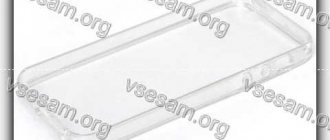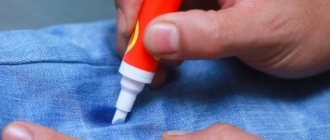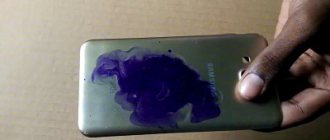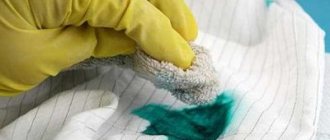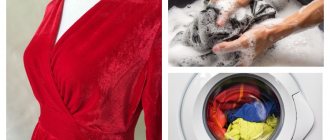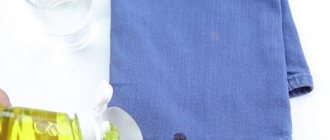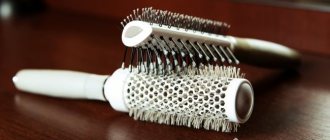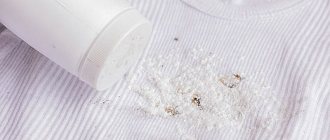An elastic and durable silicone case reliably protects your mobile phone from shocks, falls and other dangers, and protects it from moisture and dirt.
It’s no wonder that manufacturers of mobile phone accessories are producing more and more varieties of protective cases in all colors - from practical black and dark gray to festive pink, bright yellow, soft blue and even white as snow.
But bright covers get dirty easily and seem to “attract” grease, ink stains and other contaminants.
How to clean a light-colored case, returning it to its original color and without causing the slightest harm to the material from which it is made?
Rules for cleaning silicone products
In order for the case to last longer and its appearance to remain unchanged, you should follow some recommendations:
- Do not use prohibited aggressive agents, solvents or abrasives for cleaning. They destroy the structure of silicone, leaving scratches and cuts beyond repair. In addition, there is a high risk of getting a chemical burn to the skin or respiratory tract;
- Remove fresh dirt from the surface of the cover every day without waiting for it to dry. To do this, you should always have wet wipes on hand;
- It is necessary to use a soap solution for regular care at least once every few weeks. This method must be used even in the absence of visible traces of contamination.
Important! You should select the correct size of the case for your phone to avoid deformation of the silicone or accidental loss of equipment.
Have you already tried to clean your silicone phone case from dirt?
Not really
What can't you clean?
Silicone is a delicate material that is especially susceptible to mechanical damage: scratches, cuts, abrasions. When cleaning such products, you should avoid the following products:
- sponges made of metal wire;
- brushes with hard bristles;
- sharp and cutting objects: knives, blades, scissors;
- chemical solvents;
- chlorine and products containing this substance;
- abrasive powders.
Attention! Using these products will lead to the opposite result: a large number of cracks will appear on the surface of the cover, which will be filled with contaminants much faster.
Prohibited means
Silicone is a soft material that requires delicate handling. If you use inappropriate products, the silicone case may become deformed or change color. Such means include:
- devices with abrasive properties (sandpaper, metal sponges, hard brushes);
- sharp instruments (knives, needles, etc.);
- chlorine bleaches.
Silicone is easily scratched by abrasive and sharp objects. Subsequently, dirt and dust will accumulate in the cracks, and the case will lose its presentable appearance. And the use of bleach causes yellowing and clouding of the silicone.
We clean according to the type of contamination
If the type of contamination is known, then first it is worth using means aimed at eliminating it. Most often, a silicone case has the following disadvantages that arose during operation.
Yellowness
White and transparent covers are susceptible to yellowing. On multi-colored versions, this defect is less noticeable and is not noticeable.
Attention! To eliminate this defect, it is strictly forbidden to use chlorine bleach. As a result of such chemical treatment, the cover will be irretrievably lost.
Toothpaste or powder without colored dyes will help to gently remove yellow discoloration. This composition must be applied evenly to the surface and left for 15 minutes. Rinse off with warm water. If necessary, repeat the procedure to achieve the desired result.
Darkening
If the cover has darkened, then to return its original appearance you should use gasoline or a strong solution of citric acid (1 tablespoon per 0.5 liter of water).
Working with both tools is carried out subject to certain rules:
- be sure to use rubber gloves while working;
- do not immerse the entire product in the cleaning composition, do not soak it for a long time;
- to treat surfaces, use a sponge or cotton pad without using excessive force;
- Rinse off any remaining product with plenty of running water.
Dirt and stains
It is easier to wash old stains and stubborn dirt by first soaking the cover in a solution of oxygen bleach. It is strictly prohibited to use chlorine-containing products for these purposes.
The liquid or powder must be dissolved in water according to the manufacturer's instructions to whiten laundry. To increase efficiency, the solution can be heated to a warm state, without boiling.
Since a non-concentrated product is used for cleansing, exposure time is critical. The case must be in the cleaning composition for at least 2-3 hours. Then, the silicone product must be rinsed with running water and dried completely.
Ink
Fresh pen marks can be easily removed from a smooth surface using an eraser. Contamination should be treated point by point, as fresh ink can easily be smeared over the entire surface. For work, it is better to use a white eraser, without colored inclusions.
Advice! If the mark from the pen has already dried, then any essential oils will do a great job of removing it.
This composition must be applied to a cotton pad and wiped over the contaminated area. Finally, wash the cover in soapy water and dry well.
Soda
If there are serious stains from paint or traces left by glue on the panel for an Apple or Android smartphone, you need to use soda. The recipe is very simple:
- Dilute a small amount of baking soda with water to a paste;
- Apply the mixture to the affected areas;
- Leave for several hours;
- Remove the dried crust and rinse the product under running warm water.
This product allows you to clean the brilliant green and helps rid the silicone case of glue. But be careful - rub the mixture in without pressing and use a soft cloth or sponge. You can learn how to remove scorch marks from an iron on synthetic materials by following the link.
How to clean a silicone phone case?
If the type of contamination cannot be determined, then universal products should be used to clean the silicone case. Each of them has its own specifics and application features.
Gasoline for lighters
High octane fuel is best for effective stain removal. This is precisely the characteristic that gasoline for refilling lighters has. You need to wet a cotton pad with this mixture and apply it to the case without pressing.
In areas of heavy contamination, you can hold the composition for 1-2 minutes. Then the product should be washed with running water and liquid soap and dried.
Reference! Lemon juice or ammonia can deal with the unpleasant smell of gasoline.
Toothpaste
Toothpaste is not only an effective solution for eliminating yellowing, but also an excellent solution for removing stains and dirt from a clear or light-colored silicone case.
Working with toothpaste without colored dyes is very simple:
- Squeeze a few peas onto the dry surface of the cover.
- Rub the paste in a circular motion without pressing using a cotton pad or a soft-bristled toothbrush.
- Leave the composition to act for 10-15 minutes.
- Rinse the cover well with warm running water.
Liquid stain remover without chlorine
Many housewives successfully use Vanish stain remover or its analogues to remove dark stains of unknown origin from the surface of silicone. The product does not contain chlorine and is completely safe for this material.
The stain remover must be used in concentrated form or diluted with water, according to the manufacturer's instructions. Apply the composition to the case in a thin layer or soak completely in the solution, leave to act for 15-20 minutes. Upon completion of processing, rinse the product with clean water. This method of cleansing will help get rid of not only stains, but also yellowness.
Liquid soap
Liquid soap is the optimal solution for regular care of silicone products. This treatment should be performed at least once every 1-2 weeks, starting from the first day of operation. To work, you will need a few drops of liquid soap dissolved in one liter of warm water.
The cover must be placed in the solution for 30-40 minutes, then washed on all sides with a soft cloth or sponge, rinsed under the tap and dried. The transparent silicone product should be wiped with a soft, dry cloth to avoid streaks when drying.
Reference! Liquid soap can be replaced with shavings of a solid bar. To do this, it is better to use toilet or baby soap; laundry soap, in this case, may be too aggressive.
Nail polish remover
Nail polish remover can only be used on products made of transparent or white silicone. Otherwise, the design and color may fade. Preference should be given to liquids without acetone and color additives in the composition. This composition effectively copes with marks from a pen or felt-tip pen on silicone.
Important! The nail polish remover must be tested on an inconspicuous area and ensure that there are no changes in the structure of the material.
Treatment is carried out using a cotton pad soaked in liquid. Do not use abrasives or apply excessive pressure. After removing the stains, the cover should be washed in a soapy solution and left until completely dry.
Citric acid or lemon juice
Another method, used only for white and transparent products. The acidity of lemon juice will help get rid of blackness and yellowing. If this natural composition is not at hand, then you can use its chemical analogue - a solution of citric acid.
To clean, you need to moisten a cotton pad or soft cloth with juice and wipe the dark places on the product with it. Leave for 5-10 minutes until the stains lighten, rinse the product with water and dry.
Citric acid will also help in cleaning the iron and washing machine from scale.
Bleach
Only oxygen bleaches that do not contain chlorine can be used for work. Soak a cotton pad with this chemical and wipe all contaminated areas with it. Rinse the case with warm water and dry naturally.
Reference! To remove heavy stains, short-term soaking in bleach is allowed. The procedure should last no more than 1-2 minutes.
Soda
This popular home recipe allows you to effectively deal not only with household stains, but also remove traces of stickers or paint stains. Working with soda is carried out as follows:
- Dilute 1-2 tbsp. baking soda with a few drops of water to a paste-like consistency.
- Apply the mixture to the contaminated areas in a layer of about 0.5 cm.
- Leave for 1-2 hours. During this time, the soda will completely dry and become crusty.
- Remove any remaining mixture and wash the cover in soapy water.
Treating with soda will also help when the case is contaminated with brilliant green. In this case, after application, the affected area must be lightly rubbed and then left until completely dry. Repeat the procedure several times.
Read how to clean a carpet with baking soda here, and a microwave oven here.
Soda and ammonia
A mixture of soda and ammonia is used only on white or transparent covers. This product effectively removes yellowness and black abrasions on the product. To work, you will need a composition prepared from equal parts of ammonia, soda and water.
This mixture must be distributed over the entire surface of the cover and left to act for 20-30 minutes. Remove the product with a cotton swab and rinse the case in running water.
Alcohol
Undiluted rubbing alcohol effectively removes marker marks or ink stains. It can be used, among other things, on colored surfaces with a pattern, after first checking the color fastness in an inconspicuous area.
Advice! For small local contamination, it is more convenient to use a cotton swab or swab. Using light movements, without pressing or rubbing, you should treat the affected area with alcohol. Then rinse with water and dry completely before using on your smartphone.
A white or transparent cover can be completely soaked in an alcohol solution consisting of equal proportions of water and alcohol. The duration of soaking should not exceed 10 minutes. Upon completion of processing, the product must be thoroughly rinsed with running water. For colored covers, this full-immersion treatment option is not used.
Alcohol-containing solutions
Alcohol-containing solutions are used for regular maintenance and daily cleaning of the cover from fresh various contaminants. Such compositions can be:
- spray for treating displays and screens of mobile equipment;
- hand sanitizer gels;
- alcohol wipes for medical and hygienic purposes;
- special products for the care of covers and cases of mobile phones.
All these compounds can be used to wipe the case immediately after a fresh stain appears on it. In this case, no additional rinsing with water is required.
You can prepare a similar composition yourself by mixing ⅓ pure ethyl alcohol and ⅔ distilled water. To add aroma, you can add a few drops of your favorite essential oil to the mixture.
We clean the case using aggressive methods
Most contaminants can be dealt with using gentle methods, if necessary, repeating the treatment several times or using several compounds in succession. If these methods of dealing with stains do not lead to the desired result, then you can use aggressive mixtures.
Attention! It is important to remember that the result may be unpredictable, and the case may be irreparably damaged. The chances of complete cleansing and loss of original appearance are almost the same.
Boric acid and alcohol
To work, you will need boric acid, industrial alcohol and dishwashing detergent. Cleansing is carried out according to the following algorithm:
- Soak a cotton pad in industrial alcohol and wipe the case to remove fingerprints or oily stains.
- Prepare a solution of 3/4 water, ¼ boric acid and a few drops of dishwashing detergent.
- Pour this solution into the case and leave for 1-1.5 hours.
- Treat heavily soiled areas with a soft toothbrush.
- Rinse in running water and wipe dry.
High quality silicone will not change its properties as a result of such treatment. But the design applied to the case may fade slightly or be partially erased. Cheap products are likely to deteriorate after such treatment, lose elasticity or become deformed.
Chlorine bleach or sandpaper
These two remedies should be used only in extreme cases, when replacing the cover due to severe contamination is almost inevitable. You can try to clean such a product using aggressive methods, keeping in mind the high probability of its final damage.
Methods that can be used in this case:
- soaking in concentrated or diluted chlorine bleach. The processing time should not exceed a few minutes;
- cleaning using powders containing abrasive substances;
- cleaning individual elements using fine-grained sandpaper.
Important! If the case was originally purchased at a low price and the quality of the silicone from which it is made is questionable, then it is better not to waste time on processing and purchase a higher-quality replacement option. Low quality material will not withstand such aggressive measures.
How to deal with old dirt and stains
When the above methods do not give the desired result, you can use less gentle cleaning options.
- Essential oils are effective in the fight against dyes (marker, ink).
- Using sunflower oil, glue stains and traces of tape will come off.
- A melamine sponge will remove stubborn dirt.
- Alcohol-containing substances will help remove hand marks and paint stains.
- A weak bleach solution will return a decent appearance to even a very dirty product that has not been washed for a long time.
If the stains are small, take an eraser and wipe off the stains, then wash the case with soap.
How to stretch a phone case?
You need to choose a case only if the declared size fully matches the specific model of your mobile device. If these parameters match, but the product is difficult to put on and take off, then you can try to stretch it a little to the desired size.
It is necessary to heat the silicone using a household hair dryer, without bringing the nozzle of the device with hot air too close to the surface. Without allowing the case to cool, immediately put it on your mobile phone.
Reference! If the size discrepancy is obvious, then the best way is to return the unsuitable cover back to the store. Provided that no more than 14 days have passed since the date of purchase. This right of the buyer is enshrined in Federal Law No. 2300-1 “On the Protection of Consumer Rights”.
Have you tried stretching a silicone phone case yet?
Not really
Why does it turn yellow?
The cover may turn yellow due to the following factors:
- The influence of ultraviolet radiation. For this reason, the product should not be left in direct sunlight.
- Burning due to being near heating devices or excessive heating of the battery.
- Absorbing dirt. Silicone is a porous material, so even with the most careful handling, over time it will absorb dust and turn yellow.
- The influence of the process of oxidative destruction. It inevitably starts when silicone comes into contact with oxygen.
Light colored silicone cases will turn yellow over time. If you don’t want to clean them, then you should immediately buy dark-colored products. The yellowness will not be noticeable on them.
Pollution prevention
The white, colored or clear silicone case needs to be cleaned regularly. This will get rid of household contaminants and prevent the appearance of old stains. To carry out this preventive procedure, a soap solution or alcohol-containing liquids can be used.
For difficult stains, it may be necessary to soak the product for 15-30 minutes in water with the addition of a few drops of dishwashing liquid.
Other preventative measures to prevent the appearance of stubborn stains include:
- The right choice of product. You should not save on your purchase by choosing the cheapest option. Such a cover will quickly fade, turn yellow or become deformed. It will not be possible to restore its original appearance.
- The need to protect the accessory from ultraviolet radiation. This spectrum of rays leads to yellowing of the silicone, which is impossible to get rid of. Also, due to strong heating, the product darkens and its geometry changes. In most cases, such damage cannot be repaired.
- Avoid contact of the cover with potential contaminants. Do not carry your mobile phone near food, drinks or writing instruments.
- Maintain good hygiene and avoid using your phone with dirty hands.
- Remove traces of tape or sticker residue without any effort using any vegetable oil. It is enough to place a cotton pad soaked in this composition on the contaminated area and wipe the surface after 10-15 minutes.
- Removing small stains of unknown origin using a melamine sponge. This method is not suitable for patterned surfaces.
- Avoid carrying a mobile phone in close contact with denim (for example, in a pocket). A light-colored case, in this case, will inevitably turn blue.
- Carrying out daily care using a damp cloth or disc with alcohol-containing liquid.
Knowing about the features of caring for silicone products, you can easily restore the original appearance of any mobile phone case. This approach to cleansing guarantees an impeccable result in all cases.
